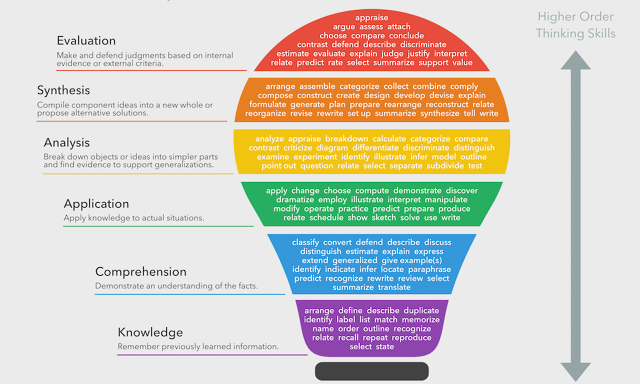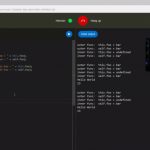This 60-Year-Old Theory Can Help You Nail Your Next Job Interview
Day by day, year by year, machines are taking over basic tasks like data collection and processing, leaving the higher-order stuff to humans. The more automation eats away at the edges of our jobs, the more we’ll need to show we’re still masters of the type of thinking skills robots can’t yet do.
That trend is pushing a framework developed more than six decades ago back into the fore. In 1956, the education theorist Benjamin Bloom and his colleagues developed what’s since become known as Bloom’s Taxonomy, a hierarchy of six types of cognitive goals they believed education should address. In 2017, it’s looking more relevant than ever.

Take Bloom On Your Next Job Interview
The framework makes it easy to identify the differences between knowing, understanding, and applying information—and, subsequently, to pinpointing the type of contribution that’s most important to companies and hiring managers. Get your head around Bloom’s Taxonomy, in other words, and you’ll stand a better shot at discussing your skills and experience on a job interview in terms that can set you apart.
Most companies ask interview questions designed to suss out candidates’ behavioral traits. And these days, hiring managers are explicitly interviewing for “soft skills” and emotional intelligence. So if someone were to answer one of those questions—like, “Tell me about a time when you had too many things to do and had to prioritize.”—using the three lowest of Bloom’s levels, they might describe how they learned how to prioritize in a time-management course (knowledge), explain its value with regard to productivity (comprehension), and then walk the interviewer through how they used one or more prioritizing techniques (application). That’s a perfectly acceptable answer, but it does little to differentiate a candidate from anyone else who might’ve picked up similar techniques.
Someone approaching the exact same question at a much higher level, using the upper three of Bloom’s categories, might say:
I created a visual of all my outstanding tasks, comparing each one with what I understood were the most pressing strategic issues, then checked with my boss to make sure I was on the right track (analysis). From there I could see patterns emerging—a few new ways I could combine certain activities to work more quickly and efficiently (synthesis). As I checked more things off my to-do list, I continually assessed what I would do differently to avoid a similar situation in the future (evaluation).
See the difference? The beauty here is that it’s all about how you frame your experience—no matter what it actually consists of. You can use the upper echelons of Bloom’s Taxonomy to discuss pretty much any kind of work-related task.
What’s more, this technique goes beyond just helping you nail behavioral interview questions. There are other formats where it can be equally effective.
Situational Interviews
“What’s always been done to successfully match employers and employees in the past isn’t working anymore,” says Sharon DeLay, president of the Columbus, Ohio–based firm Boldly Go HR. That’s why she encourages her clients to conduct situational interviews with candidates.
Unlike behavioral interviews, which focus on what a person has done in the past (or has been coached to say they did), in this type of interview a hiring manager will ask a candidate how they’d react in a very specific scenario relevant to their business, but not provide all the details. It can be really challenging.
“This is when it’s important to ask clarifying questions,” advises DeLay, adding that interviewees who do that show they’re operating at higher levels of thought: They’re evaluating what else needs to be known, then analyzing and synthesizing the employer’s responses before answering.
In situational interviews, putting Bloom’s Taxonomy to use doesn’t mean framing your experience properly—it means probing perceptively in the right direction. “It’s not about having the ‘right’ answer,” says DeLay, “but showing that you know how to ask quality questions and can work with limited knowledge before arriving at a solution.”
Case Interviews
“Why is a manhole cover round?” used to be a favored interview question at Google, until people realized you could Google the answers. Here, too, it’s not about being right or wrong but, like asking someone to come up two dozen uses for a paper clip, it’s a test of creativity.
Google has largely retired oddball brainteasers like these, but “case interviews” are far from extinct. “Case interviews are tied into thinking patterns,” says Dr. Katharine Brooks, the Evans Family Executive Director of the Career Center at Vanderbilt University. “I’ve heard of employers asking candidates how many slices of pizza were sold on campus during finals week. Or how many golf balls it would take to fill up a school bus.”
Says Brooks, “The interviewer wants to see how the candidate works through the problem, and just how much higher-order thinking is happening.”
How Job-Interview Skills Are Changing
After all, job interviewing is a skill all by itself, and the pressure to get it right may be increasing.
Opinions differ as to whether frequent job-hopping is a good or bad idea, but it’s pretty clear that workers are switching jobs more often than in the past. In fact, one recent survey suggested that some 40% of workers could leave their current employers by this time next year. In order to make those career changes successfully, exemplary interview skills will be more crucial than ever. The good news is that showcasing your ability to analyze, synthesize—which, by the way, is an increasingly common word in jobs postings like this one—and evaluate doesn’t take years of workplace experience to master. It just means keeping Bloom’s Taxonomy handy during your interview prep.
Katharine Brooks, author of the classic college-to-career book, You Majored in What?, agrees. “A lot of typical entry-level jobs have disappeared. The number-crunching, basic analysis work that used to be available in the insurance industry, for example, as a stepping stone to higher positions, is now carried out by computers. But absolutely anyone can demonstrate higher-level thinking skills, regardless of their age or experience. It’s certainly important to highlight that on your resume and demonstrate whenever possible.”
To be sure, not every employer may be willing to look beyond someone’s limited experience in the first place—or savvy enough to listen for higher-order thinking skills even among the most technically qualified candidates. “Lots of clients shoot themselves in the foot by failing to rid themselves of outmoded interview habits,” DeLay concedes. “They miss out on amazing candidates due to their own lack of creative problem-solving and higher-order thinking when devising ways to select the best-fitting candidates.”
But those are variables job seekers can’t control, and there’s still no reason not to fine-tune the ones they can.
Liz Alexander is a consulting futurist and cofounder of Leading Thought. She partners with individuals and organizations globally to help future-proof careers and businesses. Connect with Liz on LinkedIn and follow her on Twitter at @LeadThought.
Related Video: How You Really Sound In Job Interviews
Fast Company , Read Full Story
(37)














